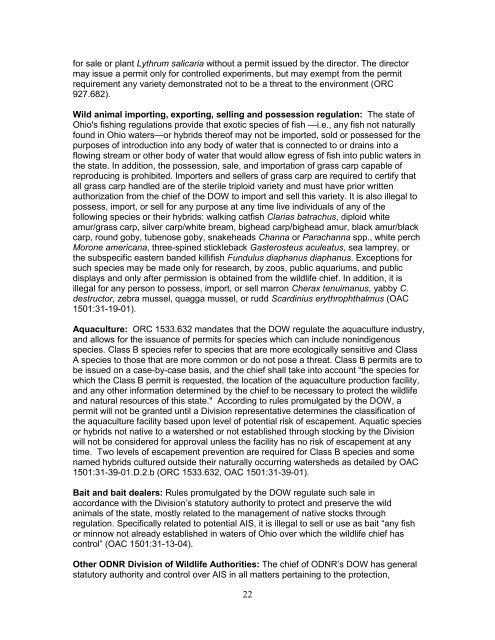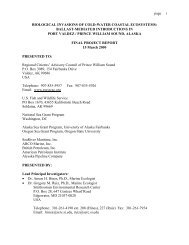State Management Plan for Aquatic Invasive Species Ohio ...
State Management Plan for Aquatic Invasive Species Ohio ...
State Management Plan for Aquatic Invasive Species Ohio ...
You also want an ePaper? Increase the reach of your titles
YUMPU automatically turns print PDFs into web optimized ePapers that Google loves.
<strong>for</strong> sale or plant Lythrum salicaria without a permit issued by the director. The director<br />
may issue a permit only <strong>for</strong> controlled experiments, but may exempt from the permit<br />
requirement any variety demonstrated not to be a threat to the environment (ORC<br />
927.682).<br />
Wild animal importing, exporting, selling and possession regulation: The state of<br />
<strong>Ohio</strong>'s fishing regulations provide that exotic species of fish —i.e., any fish not naturally<br />
found in <strong>Ohio</strong> waters—or hybrids thereof may not be imported, sold or possessed <strong>for</strong> the<br />
purposes of introduction into any body of water that is connected to or drains into a<br />
flowing stream or other body of water that would allow egress of fish into public waters in<br />
the state. In addition, the possession, sale, and importation of grass carp capable of<br />
reproducing is prohibited. Importers and sellers of grass carp are required to certify that<br />
all grass carp handled are of the sterile triploid variety and must have prior written<br />
authorization from the chief of the DOW to import and sell this variety. It is also illegal to<br />
possess, import, or sell <strong>for</strong> any purpose at any time live individuals of any of the<br />
following species or their hybrids: walking catfish Clarias batrachus, diploid white<br />
amur/grass carp, silver carp/white bream, bighead carp/bighead amur, black amur/black<br />
carp, round goby, tubenose goby, snakeheads Channa or Parachanna spp., white perch<br />
Morone americana, three-spined stickleback Gasterosteus aculeatus, sea lamprey, or<br />
the subspecific eastern banded killifish Fundulus diaphanus diaphanus. Exceptions <strong>for</strong><br />
such species may be made only <strong>for</strong> research, by zoos, public aquariums, and public<br />
displays and only after permission is obtained from the wildlife chief. In addition, it is<br />
illegal <strong>for</strong> any person to possess, import, or sell marron Cherax tenuimanus, yabby C.<br />
destructor, zebra mussel, quagga mussel, or rudd Scardinius erythrophthalmus (OAC<br />
1501:31-19-01).<br />
Aquaculture: ORC 1533.632 mandates that the DOW regulate the aquaculture industry,<br />
and allows <strong>for</strong> the issuance of permits <strong>for</strong> species which can include nonindigenous<br />
species. Class B species refer to species that are more ecologically sensitive and Class<br />
A species to those that are more common or do not pose a threat. Class B permits are to<br />
be issued on a case-by-case basis, and the chief shall take into account “the species <strong>for</strong><br />
which the Class B permit is requested, the location of the aquaculture production facility,<br />
and any other in<strong>for</strong>mation determined by the chief to be necessary to protect the wildlife<br />
and natural resources of this state." According to rules promulgated by the DOW, a<br />
permit will not be granted until a Division representative determines the classification of<br />
the aquaculture facility based upon level of potential risk of escapement. <strong>Aquatic</strong> species<br />
or hybrids not native to a watershed or not established through stocking by the Division<br />
will not be considered <strong>for</strong> approval unless the facility has no risk of escapement at any<br />
time. Two levels of escapement prevention are required <strong>for</strong> Class B species and some<br />
named hybrids cultured outside their naturally occurring watersheds as detailed by OAC<br />
1501:31-39-01.D.2.b (ORC 1533.632, OAC 1501:31-39-01).<br />
Bait and bait dealers: Rules promulgated by the DOW regulate such sale in<br />
accordance with the Division’s statutory authority to protect and preserve the wild<br />
animals of the state, mostly related to the management of native stocks through<br />
regulation. Specifically related to potential AIS, it is illegal to sell or use as bait “any fish<br />
or minnow not already established in waters of <strong>Ohio</strong> over which the wildlife chief has<br />
control” (OAC 1501:31-13-04).<br />
Other ODNR Division of Wildlife Authorities: The chief of ODNR’s DOW has general<br />
statutory authority and control over AIS in all matters pertaining to the protection,<br />
22














